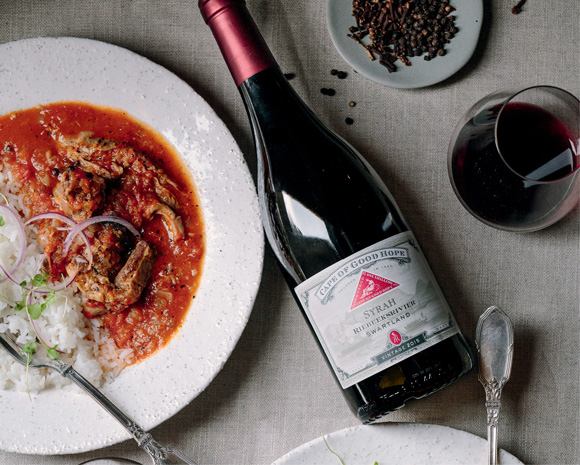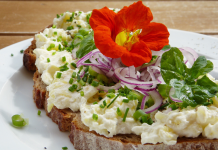… and celebrating Heritage Day with the exceptional Cape of Good Hope wines
South Africa is celebrating Heritage Day this September … and what better way to celebrate than by enjoying a meal with the family … one that includes a taste of South Africa and a nod of approval to the extraordinary Cape of Good Hope wines. The Anthonij Rupert Wyne farm – which dates back to the early 1700s, boasts an impressive wine portfolio, the most noble being the Cape of Good Hope range, which forms part of South Africa’s Old Vines Initiative. Initiated by Johann Rupert in 2007, this is regarded as a valuable contribution to the protection of South African heritage, and mirrors the Rupert family’s contributions in the preservation of heritage in other fields such as iconic art and architecture. To celebrate Heritage Day, food writer Ilse van der Merwe worked with Anthonij Rupert Wyne to develop a handful of wonderful dishes … each that pays tribute to South African tastes.

Saldanha bay mussels in wine, garlic, herbs and cream
With Cape of Good Hope Altima Sauvignon Blanc
On a warm day, a freshly steamed pot of mussels is one of the most festive ways to entertain a crowd.
Using fresh black mussels, these only need a few minutes of steaming in a fragrant, simple wine broth.
Serve with some crusty bread on the side for dipping. Serves four.
You’ll need:
1,5 kg black mussels (fresh, live mussels if you can) • 15 ml olive oil • 30 ml butter • 1 onion, finely chopped • 1-2 garlic cloves, finely grated • 6 sprigs thyme, leaves only (plus more for serving) • 250 ml dry white wine •125 ml fresh cream • a handful finely chopped parsley and a loaf of crusty bread, for serving
To make:
Place the mussels in a large bowl of fresh water (cold / room temperature) and rinse well. Remove the beards by pulling the grassy bits from the pointy edge of the mussels towards the rounded edge. Drain the water and set aside.
In a large pot, heat the oil and butter over medium heat. Add the onion, garlic and thyme, frying until it is soft and fragrant, but not too dark. Add the wine and turn up the heat to high. As soon as the liquid comes to a boil, add the mussels all at once and cover the pot with a lid. Steam for 3 minutes, then give the mussels a stir. Cover and steam for another 2 minutes, making sure that the mussels have opened properly. Remove from the heat, add the cream and give it a final stir. Ladle into bowls, scatter with the chopped parsley and some more thyme, and serve at once with crusty bread to mop up the fragrant sauce.
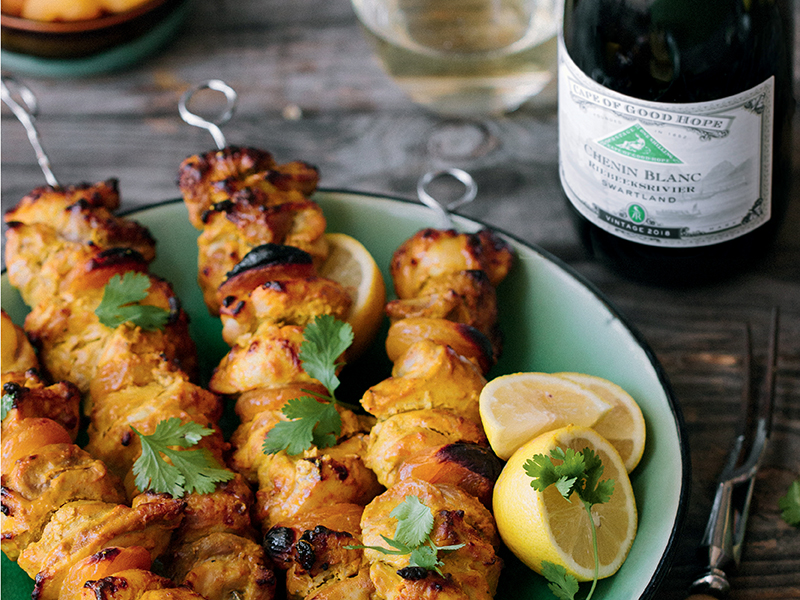
Marinated chicken tikka masala espetada with dried apricots
with Cape of Good Hope Riebeeksrivier Chenin Blanc
Chunky boneless chicken thighs are the most tender cut for these espetadas. The charred apricots add a welcome extra layer of soft texture and sweetness for a memorable curried espetada that will delight any crowd. This serves six to eight guests.
You’ll need:
2 cups plain full cream yoghurt • 1/4 cup fresh lemon juice • 2 tablespoons each of tomato paste and vegetable oil • a knob of fresh ginger, peeled & finely grated • 3 cloves garlic, peeled & finely grated • 2 teaspoons each ground coriander, ground cumin and ground turmeric • 2 tablespoons garam masala • 1,5 teaspoons salt • 1/2 teaspoon freshly ground black pepper • 1,5 kg boneless skinless chicken thighs • 250 g soft dried Turkish apricots • 6 to 8 large or 12 medium sosatie sticks/skewers • a handful fresh coriander leaves and a few fresh lemon wedges, to serve
To make:
In a large glass/ceramic/plastic bowl, mix the yoghurt, lemon juice, tomato paste, oil, ginger, garlic, coriander, cumin, turmeric, garam masala, salt & pepper. Add the boneless chicken thighs to the marinade (if the thighs are very large, cut them in half) and mix well to cover all over. Cover the bowl with a tight fitting lid or plastic wrap and leave to marinate in the fridge for at least 3 hours or up to 24 hours.
Bring the meat to room temperature by leaving it on the kitchen counter for an hour, and pre-heat your oven to 220 C (or get a fire ready to braai). Using clean hands, skewer the marinated thighs on your skewer sticks, folding them in half where necessary (don’t leave longer strands overhanging), with a few apricots inbetween. Roast in the oven at 220 C for about 25 minutes (place them on a rack fitted over a lined baking tray), or braai over medium hot coals, turning frequently to prevent burning. The apricots and marinade will blacken here and there – that’s perfect. Cook until just done, then scatter with fresh coriander and serve hot.
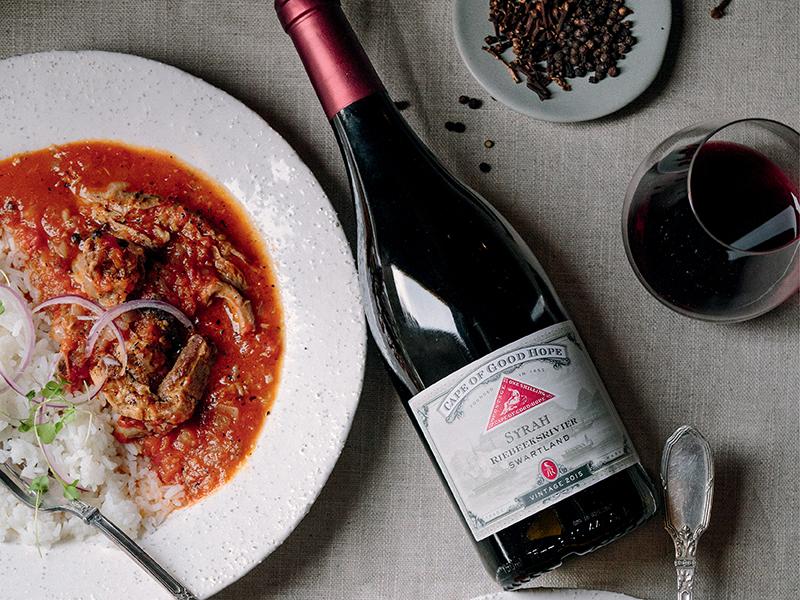
Classic cape tomato bredie
with Cape of Good Hope Riebeeksrivier Syrah
The perfumed fragrance of this humble Cape favourite will seduce you into second helpings. Don’t substitute canned tomatoes for fresh ones – the magic lies in using fresh.
Use a food processor to help with the dicing, if you want to skip some labour. Serves six guests.
You’ll need:
45 ml olive oil • 1,5 kg lamb/mutton rib chunks (or neck chops) • salt & pepper • 2 onions, chopped • 1/2 teaspoon each whole peppercorns and whole cloves • 4 whole cardamom seeds • 2 cinnamon sticks • 2 cloves garlic, finely grated • a knob of fresh ginger, finely grated (1-2 tablespoons) • 1,2 kg ripe tomatoes, diced • 5 ml sugar • 4 medium potatoes, diced (optional) • cooked jasmin or basmati rice to serve
To make:
In a large heavy based pot over medium-high heat, add the oil. Add the rib chunks and fry on the fatty side until brown, seasoning with salt & pepper as you go. Fry in batches if necessary. Remove the meat and turn down the heat to low.
Add the onions, cloves, cardamom & cinnamon sticks. Fry until translucent and soft, stirring often. Add the garlic and ginger and fry for another minute.
Add the tomatoes and sugar (and potatoes, optionally), and stir to loosen any sticky bits on the bottom of the pot. Bring the mixture to a simmer, then place the meat back into the pot and stir.
Cover with a lid, then simmer over low heat for about 1,5 hours or until the meat is very soft and falls from the bone. You can remove the bones with tongs at this point, if you want to. Taste and add more salt & pepper if necessary. Serve hot with fluffy warm rice.
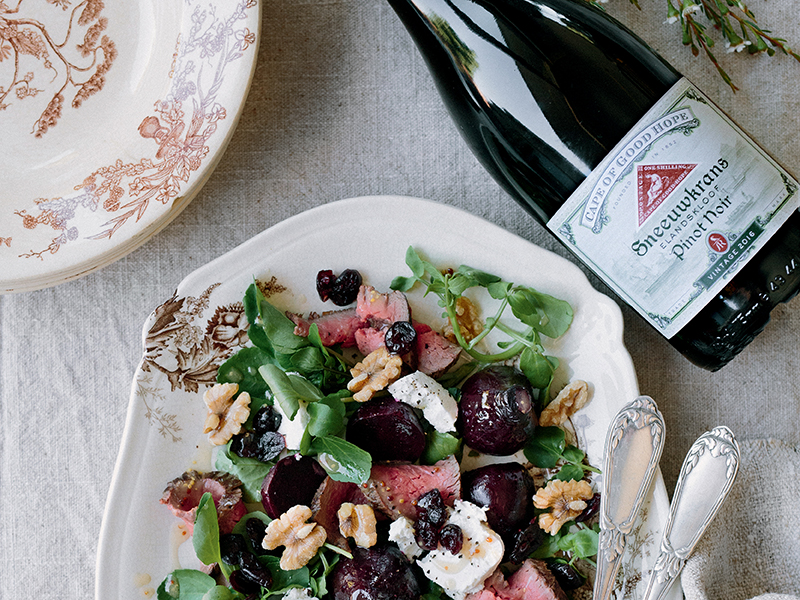
Venison salad with beetroot, cranberries, goats cheese & walnuts
with Cape of Good Hope Sneeuwkrans Pinot Noir
When the temperature warms up, we’ll all be looking for lighter alternatives and recipes that don’t take hours to prepare. A whole venison fillet can be prepped in advance and elegantly served as a starter or light meal within this salad.
Big on flavour, beautiful as a centrepiece on your table. This serves four to six.
You’ll need:
50 g dried cranberries • 125 ml red wine (preferably Pinot Noir, but any dry red wine will do) • 600 g whole venison fillet (springbok etc) • 15 ml olive oil • salt & pepper • a large bunch fresh watercress • about 300 g cooked/roasted beetroot, quartered/halved • 200 g plain soft goats cheese (chevin log), crumbled/cubed • 100 g whole walnuts
And for the dressing:
100 ml extra virgin olive oil • 30 ml red wine vinegar • 10 ml wholegrain mustard • salt & pepper, to taste
To make:
Place the cranberries in a small saucepan with the wine and bring to a simmer. Cook for about 5 to 10 minutes until most of the wine has evaporated, then remove from the heat and leave to cool. Place the fillet on a clean working surface, then rub all over with oil, and season the salt & pepper. Grill in a hot pan on all sides until cooked to your liking (pink in the middle is perfect). Remove from the heat. Leave to rest and cool, then slice thinly.
Arrange the salad … on a large platter, arrange the watercress, beetroot, sliced venison, goats cheese, cooled plumped cranberries and walnuts. Place all the ingredients for the dressing in a small jar, cover with a lid and shake vigorously. Pour the dressing over the salad and serve immediately.
Tip: If you prefer, you could also use about 300 g thinly sliced smoked, cured venison for this salad.
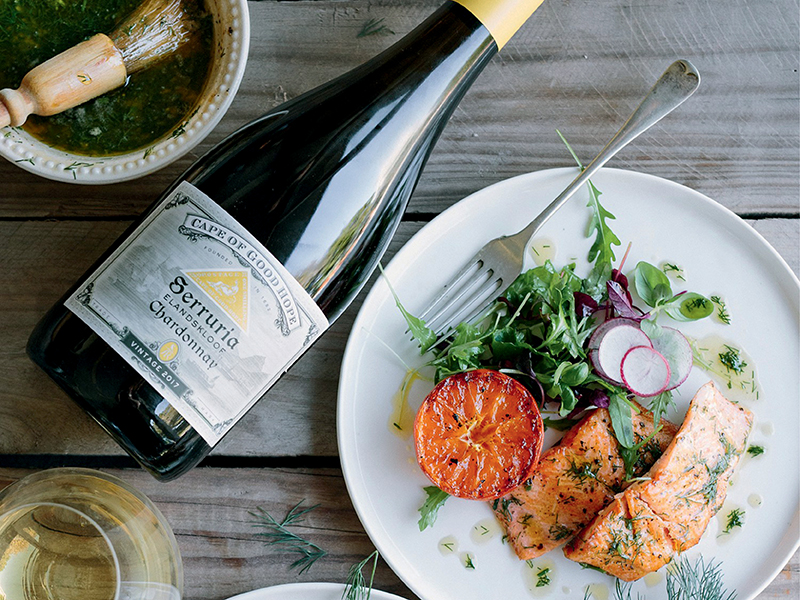
Pan-fried trout with naartjie and dill butter sauce
with Cape of Good Hope Serruria Chardonnay
Locally farmed rainbow trout is quick and easy to prepare. Ask your fishmonger to pin-bone the fillets for a completely boneless experience that’s popular with the whole family. Also an elegant choice for a dinner party. Serves 4.
You’ll need:
125 g butter •1 clove garlic, finely grated • juice of a naartjie • juice of half a lemon • a handful fresh dill, finely chopped • salt & pepper, to taste • 30 ml olive oil, for frying • 600 g fresh trout fillets (rainbow trout or salmon trout), cleaned and pin-boned, cut into portions • a crisp green salad, for serving
To make:
Make the basting sauce: in a small saucepan over medium heat, melt the butter, then add the garlic, naartjie juice, lemon juice and dill. Season with salt & pepper and stir until mixed. Boil briefly, then remove from the heat and set aside.
In a large non-stick pan, heat the olive oil over medium-high heat. Place the trout portions in the pan skin-side down and fry for about 2 to 3 minutes, seasoning the flesh side with salt & pepper. Turn over briefly and fry for another 30 seconds – don’t overcook the fish, it should still be slightly pink in the middle.
Remove the fish from the pan and plate up, spooning the sauce over the fish generously. Serve at once with a crisp green salad.
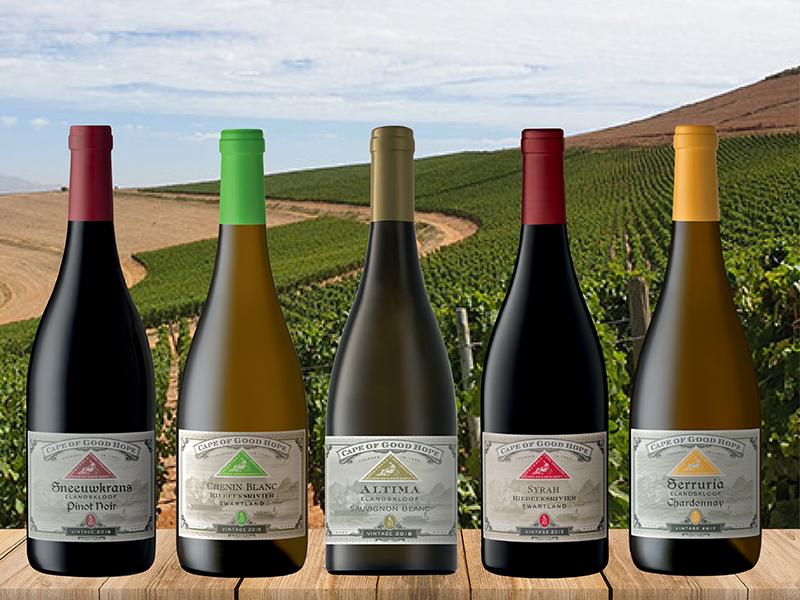
The range …
The heritage-inspired range includes the two latest additions – Riebeeksrivier Chenin Blanc and Riebeeksrivier Syrah, as well as Parel Vallei Merlot, Basson Pinotage, Serruria Chardonnay, Van Lill & Visser Chenin Blanc, Laing Semillon, Altima Sauvignon Blanc, Southern Slopes, Caroline and Sneeuwkrans Pinot Noir.
Details: capeofgoodhopewines.com

